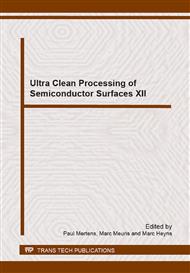p.16
p.20
p.24
p.28
p.32
p.36
p.40
p.47
p.52
Metal Removal Efficiency in Deep Submicron Trenches by Wet Chemicals
Abstract:
Metal contamination impact on transistors’ degradation has been widely studied. Nonetheless, most of the work has been performed on blanket wafers, or based on punctual yield crisis during the integrated circuits’ manufacturing. This paper proposes a comparison of the contamination and metals removal efficiency between blanket wafers and inside deep silicon trenches.
Info:
Periodical:
Pages:
32-35
Citation:
Online since:
September 2014
Authors:
Price:
Сopyright:
© 2015 Trans Tech Publications Ltd. All Rights Reserved
Share:
Citation:


